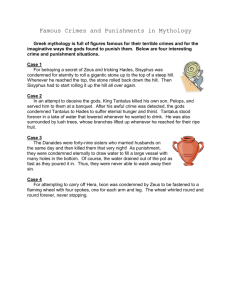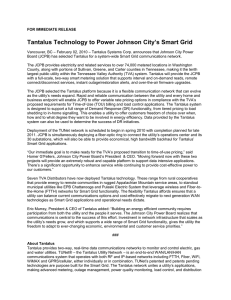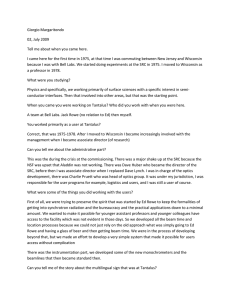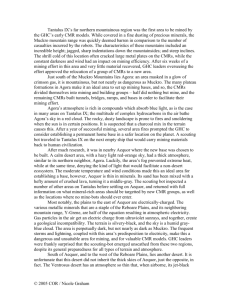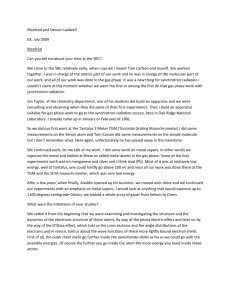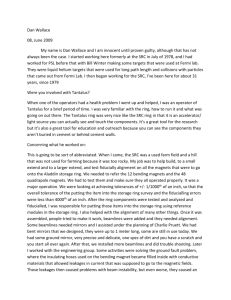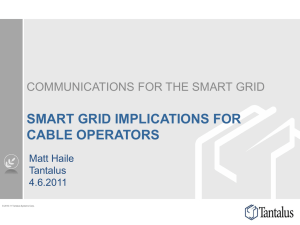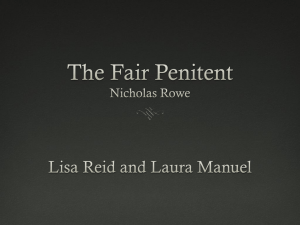Tantalus Decommissioning Videos Summations
advertisement
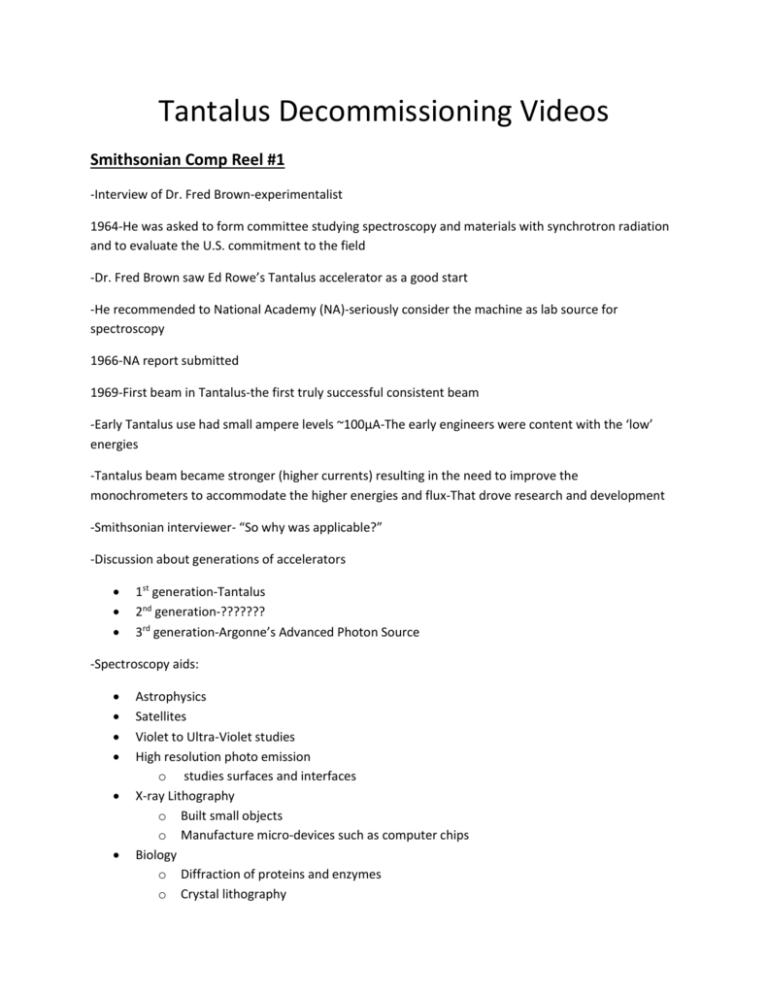
Tantalus Decommissioning Videos Smithsonian Comp Reel #1 -Interview of Dr. Fred Brown-experimentalist 1964-He was asked to form committee studying spectroscopy and materials with synchrotron radiation and to evaluate the U.S. commitment to the field -Dr. Fred Brown saw Ed Rowe’s Tantalus accelerator as a good start -He recommended to National Academy (NA)-seriously consider the machine as lab source for spectroscopy 1966-NA report submitted 1969-First beam in Tantalus-the first truly successful consistent beam -Early Tantalus use had small ampere levels ~100µA-The early engineers were content with the ‘low’ energies -Tantalus beam became stronger (higher currents) resulting in the need to improve the monochrometers to accommodate the higher energies and flux-That drove research and development -Smithsonian interviewer- “So why was applicable?” -Discussion about generations of accelerators 1st generation-Tantalus 2nd generation-??????? 3rd generation-Argonne’s Advanced Photon Source -Spectroscopy aids: Astrophysics Satellites Violet to Ultra-Violet studies High resolution photo emission o studies surfaces and interfaces X-ray Lithography o Built small objects o Manufacture micro-devices such as computer chips Biology o Diffraction of proteins and enzymes o Crystal lithography o Medical applications -Smithsonian Interviewer: “So were you a pioneer?” “We did a lot of work in spectroscopy, we were too busy to be pioneers.” -Interview with Ed Rowe: -1953 the Midwest University Research Association (MURA) was a talented and discontented group wanting high energy physics (HEP) in the Midwest -MURA took a hit with the assassination of president Kennedy in 1963 -Thunderstorms, if the lights flickered the beam was lost—still happens today in Aladdin -Charlie Pruett: was part of MURA in November 1955- finished his Ph.D. -Came to Madison in 1956 w/ MURA and worked on optics Smithsonian Comp Reel #2 Ed Rowe: -Shock of President Kennedy’s death-at both the event and the fact that President Kennedy was a supporter of high energy physics -Ed first thought of producing positrons (e+) in Tantalus however all research funding for non-national laboratories was cut off -He became interested in synchrotron radiation with inspirations from others outside Tantalus—they wanted to have a beamline port -Only cost $750 per port- “Things were a lot simpler in those days.” Roger Otte: -worrisome about end of funding -MURA split: Some physicists went to FERMI Lab in Illinois and the others stayed here around Tantalus Charlie Pruett: -Some of the first data came out on IBM punch cards -Criticisms of Tantalus: “Nothing can come of anything above 10 eV-everything washes out.” -They changed roles (all three: Ed Rowe, Roger Otte, and Charlie Pruett) from experimenters to engineers to help the users working on Tantalus to get on their feet Otte: -the field of spectroscopy and synchrotron radiation was mushrooming and the high energy physics field in general was expanding -Ed Rowe: 28:50 “Here on campus, a professor who shall remain nameless never really had a good thing to say about what was going on out here suddenly began to realize he was having little trouble filling his seminar schedule. Some of the high rolers in material sciences such as: Dean Eastmann, Jack Row, Nevell Smith, Mark Traum, and Jerry Lapeyre seemed to be in town all the time. However, they weren’t talking to people in the solid-state group up there at the University in Madison; they were always out here. Finally, this professor unbent enough to tell a story on himself: He had been at a conference in Europe and he was introduced to a head at a German institute, “well this is professor ‘so-and-so’ from Madison Wisconsin.” And the big institute head looked at him and said: “Oh! Is that anywhere near Stoughton?” -Ed Rowe then blew the professor’s cover: “I can’t believe Barney ever told that story.” It was professor Maurice Barnett (Barney) Webb Otte: -People always wanted more beam and that drove development and advancement Rowe: -Photo emission spectroscopy came along- it was a surface probe. Dean Eastman once commented on vacuums: “At 10-9 Tor, it takes 30 minutes for your sample to ROT.” Some of the beamlines had 10-11 Tor -Otte: -Tim Fairchild did space/astronomy -Photo emitters that were very sensitive. He always wanted dimmer and dimmer light contrary to most users who wanted brighter light. He wanted energies like 20 eV-very low -Dave Pearson-who worked on Aladdin wanted similar low energies NOTE: Tantalus in early years was not really international- most were post docs and students -45:00 FFAG (Tantalus first injector) was a beast-inconsistent injections -Ed Rowe was inspired by a Canadian proposed microtron and decided to construct it ~~1970’s -Stacking came about-but they did not expect to do it in Tantalus-but they eventually managed to. -50:00 Tantalus was not optimized for electrons (e-) but rather it was designed for (e+) & (e-) interactions -1969 Air Force grant-renewable every year for 5 years Physics Note: -A typical Electro magnet is about 15 kG (kilo Gauss)—Tantalus had a 3-pole electromagnet @ 24.5 kG Smithsonian Comp Reel #3 -Tantalus beamlines were cannibalized and put on Aladdin -Smithsonian Interviewer: “Why was Tantalus important?” Ed Rowe: “ The researches carried out at Tantalus in the beginning and thereafter were already being carried out elsewhere in laboratories. An answer to your question, Tantalus made what you wer trying to do in the laboratory a lot better. Now, why was Tantalus important here? Tantalus was important because it existed just at the right time. People were thinking about using synchrotron radiation, they were interested in photo emission spectroscopy and other things. They needed a better way to do it and here was Tantalus, the better way to do it.” -Smithsonian interviewer: “How did Tantalus get the name?” -Ancient Greek tale about the man Tantalus: -Also the wavelength ranges were always just a little out of reach-it opened a lot of “Tantalizing” vistas… Charlie Pruett: -lots of solid state research -similarly in computer research -Fred Brown did research with Helides- uses in photographic film -Ozone depletion studies -Also green house gases -COSTS? Compared to other accelerators this was cheap and so was Aladdin. End with tour of Tantalus Smithsonian Comp Reel #4 Continued Tour of Tantalus Facility Smithsonian Comp Reel #5 Cliff Olson: -Atmosphere of Tantalus: Experienced users helped new users then new user would become independent. That’s how the user group grew and the community was close together -learned about reflectivity of elemental metals i.e. gold reflects at 24 eV -Modulation spectroscopy: perturbing a sample methodically i.e. changing a sample’s temperature or applying an electrical charge. The point was to see if there were any differences in the reflectivity of the substance and to see if there were any changes coming from the Fermi level. Professor Jim Taylor & Cliff Olson: Jim Taylor: -As a chemist, you want the sharpest tool you can get to see how bonds in molecules are held together. You can compare it to a scalpel, the sharper the more defined you can cut. Cliff Olson: As a solid state physicist, you have IR X-rays “You know a person looks different to an X-ray than to visible light. For solids, it’s the same sort of things.” -These were wavelengths you just couldn’t get anywhere else or to the same level of accuracy compared to a lab Jim Taylor: “Even international scholars and people didn’t come in with a label, they came in with a problem that they wanted to test and there was no one who was king of the ring. They were all willing to share which made for an extremely interesting time.” “Even the theoreticians who might not have been willing to do experiments were extremely interested in the results, and they then would try to help you interpret the experiment and then devise a new one.” Cliff Olson: “The light was free and it still is today. That’s the key.” “You only paid for your chamber, personal expenses etc…” “So you could come into this business for a very low entry fee.” Jim Taylor: “People who had no gear but had a sample would come to Cliff and aks him if they could look at it. He used his expertise to give results. It made it easy for a person to evaluate their position or need for further investigation.” Eric’s Thoughts: Basically, people could come in and get a taste for the field or to see if spectroscopy etc… was applicable and beneficial to whatever they were working with. Accelerators, being an expensive enterprise can be a limiting field for anyone who doesn’t have government funding. How many Tantalus’s exist in people’s garages or even labs? Their willingness to help outsiders follow leads was invaluable. “It was that low-level of entry that made the impact on science from this facility fairly substantial.” Cliff Olson: 37:24 -The lax atmosphere contributed to the ease of things. You could just ask people for help. “I have a problem, can you help me with it?” “Yes/no/maybe” “There were no six page proposals and member reviews.” Jim Taylor: “If you had a new idea, you could test it. If it looked really exciting, then you could write a proposal.” Cliff Olson: 38:28 “That even worked for the people who were well-supported like those from Bell Labs who had financial backing in the 1970s.” -End visuals of the injector panel and two operators troubleshooting a problem with the injector Smithsonian interviewer: “Ed! Could you please vocalize what’s going on here?” Ed Rowe: “Without profanity?” Smithsonian Comp Reel #6 + Tantalus Project-532 Reel 6 -Tour of Aladdin -Shots of emanating light coming from Tantalus Sehr schön-15:20 Smithsonian Comp Reel #7-10 -Tantalus decommissioning & disassembly END OF VIDEOS
